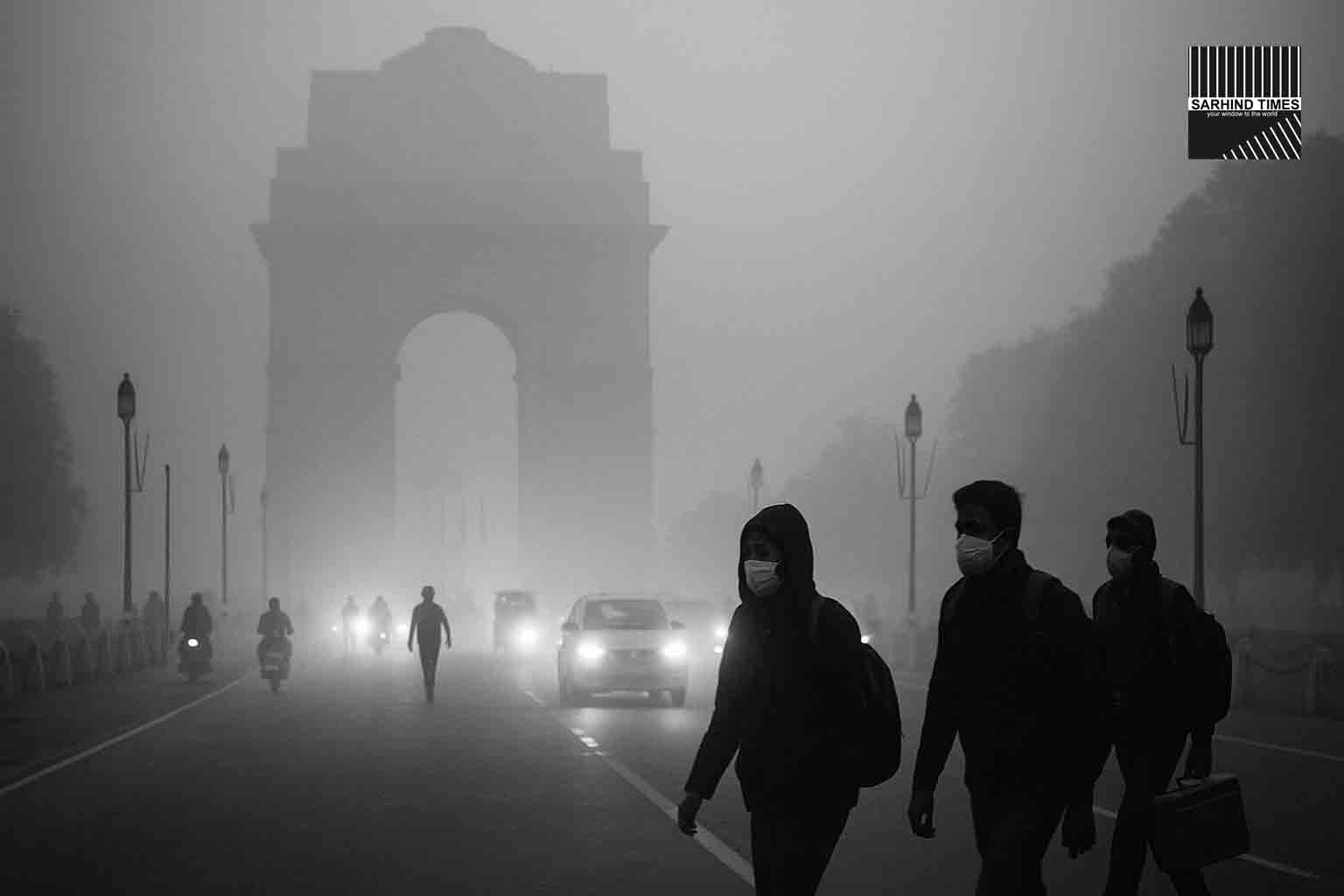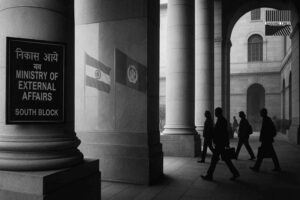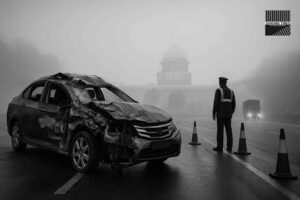Calm winds and falling temperatures push Delhi’s air quality into the ‘Unhealthy’ band; experts warn of worsening levels with stubble-burning and festive emissions on the horizon.
New Delhi | October 11, 2025
Delhi woke up under a familiar haze this morning as the city’s Air Quality Index (AQI) slipped into the ‘Unhealthy’ category, crossing 210 on real-time dashboards monitored by the Central Pollution Control Board (CPCB) and SAFAR-India.
The shift, which began around 2 a.m., marks the first sustained ‘Unhealthy’ reading of the season, driven by a combination of calm surface winds, moisture-laden air, and localized emissions from traffic, construction, and waste burning.
For the capital’s residents, it is a reminder that the annual smog cycle—long dubbed Delhi’s “fifth season”—has officially begun.
A Familiar Morning, a Fading Skyline
From Connaught Place to Dwarka, early commuters described a faint, acrid smell in the air and a milky haze dulling streetlights. Visibility fell to under 1.5 kilometers in some parts of east and south Delhi.
“By 6 a.m., my eyes were stinging,” said Rashmi Verma, a morning jogger at Lodhi Garden. “I cut my run short after checking the AQI—it was already over 220.”
Monitoring stations at ITO (239), Anand Vihar (252), Okhla Phase-II (241), and RK Puram (230) showed the steepest rise. The 24-hour average hovered between 201 and 240, officially classed as Unhealthy under India’s AQI framework.
What ‘Unhealthy’ Means
According to the Ministry of Environment, Forest and Climate Change (MoEFCC) guidelines:
- AQI between 201 and 300 is ‘Unhealthy’ — it may cause respiratory discomfort to people with lung or heart conditions and irritation to healthy individuals after prolonged exposure.
- The dominant pollutants—PM2.5 and PM10—are tiny airborne particles from combustion and dust that can penetrate deep into the lungs and bloodstream.
Doctors warn that sustained exposure at this level can cause coughing, wheezing, fatigue, and, over time, aggravate chronic asthma and bronchitis.
“Masks are essential now,” said Dr. Rakesh Kumar, pulmonologist at AIIMS. “N95s or equivalent filters should be used, especially by children and elderly citizens.”
Medical Advisory: Breathing Under Siege
Hospitals across Delhi NCR report a 10–12% rise in outpatient visits for respiratory distress over the past week.
“We’ve started seeing classic early-winter symptoms—dry cough, nasal irritation, tightness in chest,” said Dr. Neha Khanna of Max Hospital. “Air pollution is a silent epidemic in this city.”
Doctors recommend:
- Avoid early-morning walks when pollutants are trapped near ground level.
- Use air purifiers indoors, particularly in bedrooms.
- Drink warm fluids and maintain humidity levels to reduce throat irritation.
- Avoid outdoor exercise during peak pollution hours (5–9 a.m. and 6–10 p.m.).
Administrative Response: Graded Action Plan Re-Activated
The Delhi government and the Commission for Air Quality Management (CAQM) have reactivated several measures under Stage I of the Graded Response Action Plan (GRAP).
Implemented each year between October and March, GRAP is a stepwise strategy designed to counter escalating pollution.
Stage I includes:
- Strict enforcement of dust control at construction sites.
- Water-sprinkling and mechanized sweeping on arterial roads.
- Ban on open waste burning and crackdowns on defaulters.
- Advisories for public transport use and vehicle idling checks at intersections.
“Inspections have been intensified,” said Environment Minister Gopal Rai. “Teams from DPCC and MCD are conducting surprise checks at over 500 sites daily.”
The Science Behind the Spike
Meteorologists attribute the current deterioration to temperature inversion—a weather phenomenon where a layer of cool air gets trapped near the ground, preventing pollutants from dispersing.
“Surface winds have dropped below 5 km/h,” explained IMD scientist V.K. Soni. “Combined with early morning moisture, pollutants are accumulating overnight.”
Satellite imagery also showed increased fire activity in parts of Punjab and Haryana, signaling the start of stubble-burning season—a recurring factor that aggravates Delhi’s winter smog.
The Stubble-Burning Factor
Data from the Indian Agricultural Research Institute (IARI) indicates over 1,200 fire events in northwestern India in the past 48 hours. While still below peak levels, experts warn the trend is set to accelerate through late October.
“Once farm fires peak, PM2.5 levels could double,” said Dr. Gufran Beig, founder of SAFAR. “Without wind dispersion, Delhi becomes a closed chamber.”
The Delhi government continues to promote bio-decomposer solutions for crop residue and is coordinating with neighboring states under the ‘Parali-Free NCR’ initiative, but adoption remains uneven.
Citizens React: From Frustration to Fatigue
For many residents, pollution has become a seasonal inevitability.
“Every year it’s the same story—government meetings, fines, and nothing changes,” said Arjun Mehta, an IT professional from Dwarka. “It’s like déjà vu with worse air.”
Social media platforms saw hashtags like #SmogDelhi and #CleanAirNow trend by morning, with citizens sharing AQI screenshots and visibility videos.
Resident welfare associations (RWAs) have also begun community-level responses—arranging indoor fitness sessions, distributing masks, and organizing tree-planting drives.
“We can’t wait for miracles,” said Meenakshi Tandon, president of a housing society in East Delhi. “Small actions count when breathing itself feels political.”
Health Implications Beyond Respiratory Illness
Long-term studies link Delhi’s air pollution to reduced lung capacity in children, increased cardiac risk, and mental fatigue among adults.
A 2024 study by the Energy Policy Institute at the University of Chicago (EPIC) found that Delhi residents lose up to 11 years of life expectancy if current air quality levels persist.
“This isn’t just a public health crisis—it’s an economic one,” said EPIC’s Rohan Pandey. “Poor air quality reduces labor productivity and increases healthcare costs exponentially.”
Festive Season Factor: Crackers, Traffic, and Chaos
The approach of Dussehra, Diwali, and Chhath Puja is expected to worsen Delhi’s air quality unless citizens cooperate with enforcement guidelines.
The Delhi Pollution Control Committee (DPCC) has maintained a complete ban on firecrackers, including so-called “green crackers,” across NCR.
Traffic congestion is another aggravator. Peak-hour traffic contributes nearly 30% of PM2.5 load in some urban pockets.
“Public transport and carpooling must be normalized, not exceptional,” said urban planner Anumita Roychowdhury of CSE. “Individual behavior is policy in action.”
Economic Impact: The Cost of Bad Air
Pollution has measurable economic fallout. A 2025 report by NITI Aayog estimated that India loses nearly 1.3% of GDP annually due to productivity decline and healthcare expenditure linked to air pollution.
Delhi alone spends billions combating smog—from health subsidies to air filtration projects—yet the root sources remain resilient.
“Without addressing agricultural burning and vehicular transition, we are just sweeping smoke,” said economist Dr. Ritesh Rajan.
Children and Schools: An Invisible Threat
Schools across Delhi NCR are under advisories to limit outdoor assemblies and PE sessions when AQI exceeds 200.
“Children breathe twice as fast as adults,” explained pediatrician Dr. Ritu Ahuja. “Pollutant exposure during growth years causes irreversible harm.”
Air purifiers are now installed in several private schools, while government schools are adopting natural filtration measures such as green walls and dense vegetation barriers.
Government Appeal: Collective Action Needed
Delhi Chief Minister Arvind Kejriwal reiterated citizens’ role in combating pollution:
“Government alone cannot clean the air. Each citizen must take responsibility—avoid diesel generators, use public transport, and report violators.”
He added that real-time grievance portals and air quality dashboards would remain open for citizen feedback throughout winter.
Comparative Snapshot: Delhi vs Other Cities
| City | Current AQI (7 a.m.) | Category |
| Delhi | 228 | Unhealthy |
| Gurugram | 217 | Unhealthy |
| Noida | 202 | Unhealthy |
| Mumbai | 122 | Moderate |
| Bengaluru | 68 | Satisfactory |
| Kolkata | 138 | Moderate |
While Delhi remains the most polluted among metros, northern neighbors are also showing deterioration as wind circulation weakens.
Expert Commentary: The Way Forward
“Short-term bans cannot replace long-term transitions,” said Sunita Narain, environmentalist and Director General of CSE. “We need sustained investment in clean mobility, rural mechanization, and decentralized energy.”
She highlighted the success of Delhi’s odd-even traffic scheme, suggesting that seasonal reimplementation could temporarily reduce load if enforced strictly.
Technology and Innovation: New Frontiers
Delhi’s civic agencies are exploring AI-based dust monitoring, drone surveillance for waste burning, and low-cost ambient sensors for hyperlocal mapping.
Private innovators are piloting portable HEPA-filter kiosks, and IIT Delhi recently launched an app predicting pollution hotspots three hours in advance using machine learning.
“Data transparency builds accountability,” said Prof. Sagnik Dey of IIT Delhi’s Centre for Atmospheric Sciences. “Citizens can act only when informed.”
Public Engagement: Beyond Complaints
Environmental NGOs like Help Delhi Breathe and Care for Air are urging collective civic action — from rooftop composting to car-free days.
“Behavioral change is our biggest missing link,” said initiator Bhavreen Kandhari. “Every small act—turning off an engine, saying no to crackers—adds up.”
Long-Term Solutions: From Policy to Practice
- Cleaner Fuels: Accelerate transition to electric and hybrid vehicles.
- Green Infrastructure: Urban forests, green belts, and biofilters in hotspots.
- Construction Code Enforcement: Mandate dust curtains and vacuum collection.
- Agricultural Reform: Incentivize stubble management equipment and residue markets.
- Cross-State Coordination: Create an Air Quality Regional Council beyond political jurisdictions.
“Pollution is not Delhi’s alone—it’s a northern plains crisis,” emphasized CPCB Chairman S.P. Singh Parihar. “We must act as a collective ecosystem.”
Citizens’ Checklist: Reducing Exposure
✔️ Track real-time AQI using CPCB or SAFAR apps
✔️ Use N95 or KN95 masks outdoors
✔️ Keep windows closed during morning and evening hours
✔️ Use air purifiers with HEPA filters indoors
✔️ Include jaggery, tulsi, ginger, and steam inhalation in daily routine
✔️ Avoid outdoor runs or workouts in high-AQI zones
Conclusion: A City Holding Its Breath
Delhi’s air emergency is neither sudden nor surprising. What changes year to year is not the pollution, but the public’s patience.
From policy summits to press conferences, the numbers repeat—but the air remains heavy. For millions of Delhiites, every breath is now a calculation between risk and routine.
As one commuter put it while donning a mask at India Gate:
“We used to check weather forecasts. Now we check air forecasts.”
With winter setting in, Delhi once again stands at the crossroads of urgency and apathy — its skyline fading, its lungs waiting for relief that seems perennially postponed.
#Delhi #AQI #AirPollution #PublicHealth #PM25 #CleanAir #Environment #SmogSeason #ClimateCrisis #SarhindTimes






















+ There are no comments
Add yours